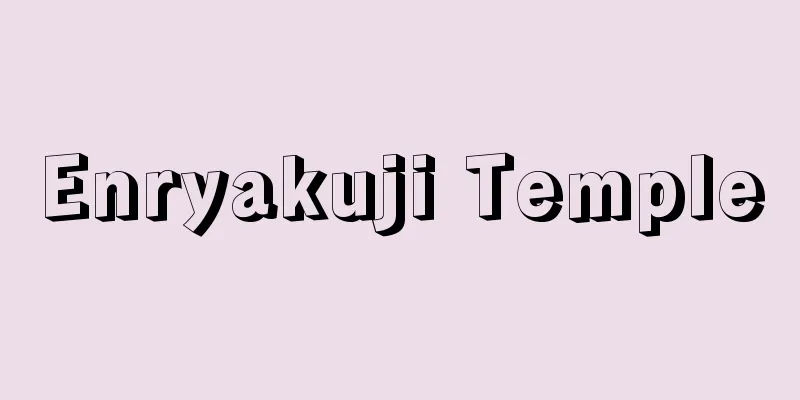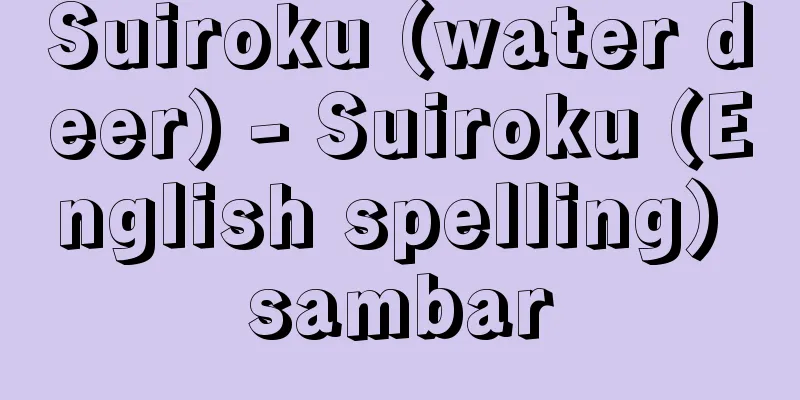Enryakuji Temple

|
The head temple of the Tendai sect is located in Sakamoto Honmachi, Otsu City. The mountain name is Mount Hiei. The mountain range that spans from Shiga Prefecture to Kyoto Prefecture, including Daihiei, Shimeigadake, and Shakadake, is called Mount Hiei (Hieyama), and the three towers and halls scattered throughout Ichirokudani are collectively called Enryakuji. The three towers come from Rokushohotoin, where Saicho built six pagodas in six places around Japan to pray for the protection of the country and to enshrine the Lotus Sutra. Of these, the Eastern Pagoda (Omi Hotoin) was built on the Shiga Prefecture side of Mount Hiei, and the Western Pagoda (Yamashiro Hotoin) was built on the Kyoto side. Later, Ennin opened the Northern Pagoda (Konpon Nyoho Pagoda), and these three sections are collectively known as the Three Pagodas. [Tamura Kosuke] historyAccording to the Kojiki, Mount Hiei has long been considered the home of Oyamagui-no-kami, and it is believed that ascetic monks lived there. In the Nara period, a hermitage was established there as a place for ascetic training in the mountains, as can be seen from the poem by Asada Renyoshun in Kaifuso. Enryaku-ji Temple was founded when Saicho entered Kokubunji Temple in Omi (Shiga Prefecture) at the age of 12, and after receiving the ordination and precepts, he wrote a prayer in 785 (Enryaku 4), and entered Mount Hiei with a firm resolve to practice asceticism and built a hermitage there. In 788, he built the Konponchudo Hall and enshrined a Yakushi Buddha that he had made himself, and the temple was later called Ichijo Shikan-in. Heian-kyo was established 9 years after his arrival on the mountain, and Enryaku-ji Temple was later made the temple of the imperial palace. Saicho traveled to China as a student returning from China, visiting Mount Tendai and other sites where the Tendai sect was based, and received the Tendai, Esoteric, Mahayana, and Zen teachings. In 806, he received an annual quota of two monks to be ordained as Tendai monks, and Tendai was officially recognized as an independent sect. Saicho then engaged in doctrinal debates with Tokuitsu of Aizu and others, and established a new Kaidan (ordination platform), one of only three in Japan at the time, on Mount Hiei, and attempted to make Tendai independent from the Buddhist sects in Nara as a sect that trained pure Mahayana monks by granting only Mahayana precepts. This was approved on the seventh day after Saicho's death in 822 (Kōnin 13), and the following year the temple was given the imperial seal of Enryaku-ji Temple. Saicho's disciples included Gishin and Encho, who built more temples and pagodas, but the teachings that Saicho brought from China did not fully cover esoteric Buddhism, so Jikaku Daishi Ennin and Chisho Daishi Enchin traveled to China and brought esoteric Buddhism to China. By the time of An'nen, Tendai's esoteric Buddhism (abbreviated as Taimitsu) had been perfected, and combined with Shingon Buddhism, the Heian period became a period dominated by esoteric Buddhism. Within Tendai, the schools of Jikaku Daishi and Chisho Daishi came into conflict, and finally the monks of Chisho Daishi's lineage moved to Onjo-ji Temple in 993 (Shoreki 4), splitting into the mountain gate (Enryaku-ji Temple) and the temple gate (Onjo-ji Temple), and repeatedly engaged in conflicts, including burning down buildings. At the same time, warrior monks began to be kept in the mountains. In addition, in the mid-Heian period, the Jikaku Daishi school split into the Taninoryu (the school of Kokei from Minamitani in the Toto Pagoda) and the Kawanoryu (the school of Kakucho from Yokokawa), and these further branched out into smaller schools, eventually becoming the thirteen schools of Taimitsu. Ennin introduced the Hosho-ryu Nembutsu of Mount Wutai in the Tang Dynasty, built Shuryogon-in Temple in Yokokawa, and began copying the Lotus Sutra (Nyohokyo). In the mid-Heian period, Pure Land Buddhism flourished, and Jie Daishi (Gansan Daishi) Ryogen, the founder of Mount Hiei's restoration, and his disciples Genshin and Kakuun all promoted Pure Land faith. Among them, Eshin Sozu Genshin lived at Yokokawa Eshin-in Temple and wrote Ojoyoshu. In addition, Kuya traveled around the country (Yugyo) and spread Nembutsu, earning the title of Ichinohijiri, while Ryonin retired from Mount Hiei to Ohara, where he learned the teachings of Amida Buddha, established the foundation for Yuzu Nembutsu, and traveled around the country. Nembutsu was also respected among the nobility, and many Amida halls and statues of Amida Buddha were built, which became the basis for the development of Pure Land Buddhism in Japan. From the end of the Heian period to the Kamakura period, monks who had studied and trained at Mount Hiei left the mountain to create new sects. Honen (Genku), who studied at Enryaku-ji from age 15 to 43, founded the Jodo sect, Shinran, who studied from age 9 to 29, founded the Jodo Shinshu sect, and Ippen (Chishin), a disciple of Jodo sect's Shotatsu, founded the Jishu sect. Eisai, who entered Mount Hiei at age 19, founded the Rinzai sect, Dogen, who founded the Soto sect from age 13 to 18, and Nichiren, who founded the Nichiren sect from age 22 to 32. Meanwhile, from the mid-Heian period, the warrior monks gained power, fighting against Onjo-ji Temple and others, and making strong appeals to the Imperial Court carrying the Hiyoshi portable shrine. They also played a part in the conflict between the Northern and Southern Courts, and sided with the Southern Court during the Kenmu Restoration. However, in 1571 (Genki 2), Oda Nobunaga burned down the entire temple, killing several thousand people. After that, Toyotomi Hideyoshi gave permission to rebuild the temple gate, and Hideyoshi and Tokugawa Ieyasu gave them land, which allowed the temple to be restored. Tenkai of the Tendai sect wielded power as Ieyasu's aide, building Toeizan Kan'ei-ji Temple in Ueno, Edo, and burying Ieyasu at Nikko's Toshogu Shrine. He also made great contributions to the restoration of Enryaku-ji Temple, and during the Edo period, the temple buildings and pagodas, including the Konponchudo Hall, were rebuilt. In addition, Hiyoshi Sannosha Shrine was revered as the guardian deity of Enryaku-ji Temple based on the Honji Suijaku theory, and with the doctrinal backing of the Tendai sect, Sanno Ichijitsu Shinto (Sanno Shinto) arose and developed. However, due to the separation of Shinto and Buddhism during the Meiji Restoration, it became independent from Mount Hiei. [Tamura Kosuke] Three TowersHigashito, Nishito and Yokokawa each have developed with different histories, and temples and pagodas are scattered throughout the Go-Go-Roku valleys. The East Pagoda is divided into five valleys: Kitadani, Minamidani, Nishidani, Higashidani, and Mudojidani. Here, you will find the Konponchudo (National Treasure), the center of Enryakuji Temple, which contains three altars that preserve the flame of eternal law and show the shape of the temple when it was founded by Saicho. Other major buildings and towers include Ichijo Kaidan-in, the place where monks received their precepts, the Daikodo (Lecture Hall) where monks studied academically, Monjuro, which serves as the gate to the Konponchudo, the Hokke Soji-in East Pagoda where kanjo (abbot's ordination) and precepts were administered, and Jodo-in, Saicho's mausoleum. Mudojidani is also home to Mudoji Temple, the center of Kaihogyo (traditional Buddhist pilgrimage). The West Pagoda is divided into the five valleys of Higashidani, Minamidani, Kitadani, Minamiodani, and Kitaodani, as well as Bessho Kurodani. It contains the Shakado (Tenporin-do), the oldest hall on the mountain, built in the Kamakura style, the Jogyo-do, where Jogyo-sanmai (constant practice of meditation) is performed, and the Hokke-do, where Hokke-sanmai (constant practice of the Lotus Sutra) is performed. The Jogyo-do and Hokke-do are connected by a corridor and are commonly known as "Benkei's Ninaido." On the hill behind the Shakado is the Sorin-to, where only the spire stands tall above the ground. The Yokokawa River is divided into six valleys - Kahou Valley, Tosotsu Valley, Kaishin Valley, Hannya Valley, Gedatsu Valley, and Imuro Valley - as well as Bessho Anraku Valley. Among its many sites are the Yokokawa Chudo Hall founded by Ennin, the Konpon Nyoho Pagoda which houses copied sutras started by Ennin, Eshin-in Temple where Eshin Sozu lived, Gansan Daishi Hall (Shiki Lecture Hall) which is the former residence of Ryogen, and Gyoin Temple, a training ground for monks. [Tamura Kosuke] Annual EventsThere are as many as 50 different annual events held at the many halls and pagodas of Enryaku-ji Temple, but here we will write about the main ones. The Shusho-e ceremony is held from New Year's Eve to January 3rd, and is particularly famous for the warding off evil spirits and driving away ritual held in the Konponchudo Hall amidst bonfires. The Gyoikajimi-shiho ceremony is held at Konponchudo Hall from April 4th to 11th, where the Emperor's clothes are enshrined and prayers are made for peace and prosperity for the nation. The Nyohoshakyo-e ceremony is held at Yokokawachudo Hall in early July, where copies of the Lotus Sutra, which began with Ennin, are made. The Tozu-seppo ceremony is a sermon on the Lotus Sutra from August 21st to 25th at Tonan-ji Temple on the shores of Lake Biwa. The Shimozukie is held in the Great Lecture Hall on the anniversary of the death of the Tendai Daishi (Chigi) (October 23rd and 24th) as a token of gratitude to him. The Hokke Taikai is held once every five years in the Great Lecture Hall to pray for the prosperity of the nation and the flourishing of Buddhism, and to hold debates on Tendai doctrine. Its official name is Kougakuryugi. On Mount Hiei, strict training in the form of meditation and contemplation is undertaken. This includes 12 years of seclusion at Jodo-in Temple, where one completes academic training and worship. The Sennichi Kaihogyo, which is said to have been started by the monk Souou (831-918) in the early Heian period, is known as a difficult practice that involves circumambulating the peaks for 1,000 days over a period of seven years, even traveling all the way to Kyoto, and fasting for nine days and abstaining from water. [Tamura Kosuke] Temple treasuresThe National Treasures include calligraphy such as "Dengyo Daishi's Future Mokuroku," "Katsuma Kongo Mokuroku," "Tendai Hokeshu Nenbun Engi," "The Biography of the Sixth Patriarch Enou," "Emperor Saga's Imperial Letter on the Precepts of Kojo," and "Certificate on Dengyo Daishi's Entry into China," as well as the "Gilded Bronze Sutra Box," "Hosso Flower Makie Sutra Box," and the Shichijo Shinougesa and Shinouue robes that Dengyo Daishi wore in the future. In addition, there are many other National Important Cultural Properties, such as a portrait of Tendai Daishi, statues of the Five Great Wisdom Kings, and "Kegon Yogi Mondo" written by Gyofuku. In addition, Enryaku-ji Temple was registered as a World Heritage Site in 1994 (Heisei 6). (World Heritage Site. Kyoto's cultural assets include 17 shrines, temples, and castles, including Kiyomizu-dera Temple.) [Tamura Kosuke] "History of the Tendai Sect in Japan" by Ueno Fumihide (1936, Hajinkaku Shobo)" ▽ "Saicho and the Tendai Sect" by Kiuchi Takao (Kyouikusha, Rekishi Shinsho)" ▽ "Mount Hiei" by Kageyama Haruki and Murayama Shuichi (NHK Books)" ▽ "Mount Hiei Temple" by Kageyama Haruki (1978, Dohosha Publishing)" [References] | | | [Additional information] |The building in the back is the Konponchudo (national treasure), and in the foreground is the corridor (nationally designated important cultural property). Part of the World Heritage "Historic Monuments of Ancient Kyoto (Kyoto City, Uji City, Otsu City)" (registered in 1994) Otsu City, Shiga Prefecture © Lake Biwa Visitors Bureau "> Enryakuji Temple (East Pagoda) Main Hall Nationally designated Important Cultural Property; Part of the World Heritage Site "Cultural Monuments of Ancient Kyoto (Kyoto City, Uji City, Otsu City)" (registered in 1994); Otsu City, Shiga Prefecture © Lake Biwa Visitors Bureau, Public Interest Incorporated Association "> Enryakuji Temple (East Pagoda) Kaidan-in Nationally designated Important Cultural Property Part of the World Heritage Site "Cultural Assets of the Ancient Capital of Kyoto (Kyoto City, Uji City, Otsu City)" (registered in 1994) Otsu City, Shiga Prefecture © Lake Biwa Visitors Bureau, Public Interest Incorporated Association "> Enryakuji Temple (West Pagoda) Shakado Hall Nationally designated Important Cultural Property Part of the World Heritage Site "Cultural Monuments of Ancient Kyoto (Kyoto City, Uji City, Otsu City)" (registered in 1994) Otsu City, Shiga Prefecture © Lake Biwa Visitors Bureau, Public Interest Incorporated Association "> Enryakuji Temple (West Pagoda) Rurido Hall Part of the World Heritage Site "Cultural Monuments of Ancient Kyoto (Kyoto City, Uji City, Otsu City)" (registered in 1994) Otsu City, Shiga Prefecture © Lake Biwa Visitors Bureau, Public Interest Incorporated Association "> Enryakuji Temple (Yokokawa) Yokokawa Chudo Hall Source: Shogakukan Encyclopedia Nipponica About Encyclopedia Nipponica Information | Legend |
|
大津市坂本本町にある天台宗の総本山。山号は比叡山(ひえいざん)。滋賀県から京都府にまたがる、大比叡(だいひえい)、四明(しめい)ヶ岳、釈迦(しゃか)岳などを含む山並みを比叡山(日枝(ひえ)山)と称し、そのなかの三塔一六谷に点在する堂塔を総称して延暦寺という。三塔とは、最澄(さいちょう)が護国を祈るため日本中の6か所に宝塔を建て『法華経(ほけきょう)』を安置しようと発願した六所宝塔院(ろくしょほうとういん)に由来する。そのなかの東塔(とうとう)(近江(おうみ)宝塔院)が比叡山の滋賀県側に、西塔(さいとう)(山城(やましろ)宝塔院)が京都側につくられ、のち円仁(えんにん)により横川(よかわ)(北塔、根本如法(こんぽんにょほう)塔)が開かれ、その3区分を総称して三塔という。 [田村晃祐] 歴史比叡山は『古事記』によると古くから大山咋神(おおやまぐいのかみ)が鎮座する所とされ、修験(しゅげん)行者が入っていたと考えられる。奈良時代には山林修行の場所として草庵(そうあん)が設けられていたことが、『懐風藻(かいふうそう)』の麻田連陽春(あさだのむらじやす)の詩からわかる。延暦寺は、最澄が12歳で近江(滋賀県)の国分寺に入り、得度(とくど)・受戒(じゅかい)ののち785年(延暦4)「願文(がんもん)」をつくり、堅い修行の決意をもって比叡山へ入り、草庵を結んだのに始まる。788年に根本中堂を建て自作の薬師仏を安置したといい、のち一乗止観院(いちじょうしかんいん)と称した。平安京が営まれたのは入山後9年目で、のちに延暦寺は皇城鎮護の寺とされた。最澄は還学生(げんがくしょう)(遣唐使に随行して唐へ往復する学徒)として入唐(にっとう)、天台宗の根拠地天台山その他を訪れ、天台、密教、大乗戒、禅を受けて帰国、806年、年分度者(ねんぶんどしゃ)(毎年天台宗の僧として得度・受戒すべき僧)の割当て2名を得て、天台宗が独立した宗派として公認された。その後、最澄は会津の徳一などと教理論争を行い、また、当時日本中に3か所のみであった戒壇(かいだん)を新しく比叡山上にも設け、大乗戒だけを授けることにより、天台宗を純粋な大乗の僧を養成する宗派として奈良の仏教教団から独立させようとした。これは822年(弘仁13)最澄の没後7日目に許可され、翌年には延暦寺の勅額を賜った。 最澄の門下に義真(ぎしん)、円澄(えんちょう)らが輩出し、堂塔を増建したが、最澄が唐から伝えた教学のなかでは密教が不十分で、慈覚(じかく)大師円仁、智証(ちしょう)大師円珍(えんちん)が入唐して密教を伝えた。安然(あんねん)に至って天台の密教(台密(たいみつ)と略称)は大成され、真言宗と相まって、平安時代は密教中心の時代となった。天台内では慈覚大師系と智証大師系が対立抗争するようになり、ついに智証大師の系統の僧は993年(正暦4)園城寺(おんじょうじ)へ移り、山門(延暦寺)と寺門(園城寺)に分かれ、互いに焼打ちをするなど抗争を繰り返した。それとともに山中には僧兵が養われるようになった。また、慈覚大師流は平安中期に谷流(たにのりゅう)(東塔南谷の皇慶(こうけい)の法流)と川流(かわのりゅう)(横川の覚超(かくちょう)の法流)に分かれ、それらはさらにまた細かく分派し、台密十三流にも細分化されていった。 円仁は唐の五台山の法照流念仏を導入し、横川に首楞厳院(しゅりょうごんいん)を建て、『法華経』の写経(如法経(にょほうきょう))を始めた。平安中期には浄土思想が隆盛となり、比叡山中興の祖慈慧(じえ)大師(元三(がんさん)大師)良源(りょうげん)、その弟子源信(げんしん)、覚運(かくうん)らはいずれも浄土信仰を鼓吹した。なかでも、恵心僧都(えしんそうず)源信は横川恵心院に住し、『往生要集(おうじょうようしゅう)』を著した。また、空也(くうや)は全国を回って(遊行(ゆぎょう))念仏を広めて市聖(いちのひじり)などとよばれ、良忍(りょうにん)は比叡山から大原(おおはら)に隠棲(いんせい)し、阿弥陀仏(あみだぶつ)の教えを受けて融通(ゆうずう)念仏の基をつくり、全国を遊行した。貴族の間でも念仏が尊重され、阿弥陀堂や阿弥陀仏が多くつくられるなど、日本の浄土教発展の基ともなった。 平安末期から鎌倉時代にかけ、比叡山で学問・修行した僧が比叡山を出て新しい宗派をつくった。15歳から43歳まで延暦寺で学んだ法然(ほうねん)(源空(げんくう))が浄土宗、9歳から29歳まで学んだ親鸞(しんらん)が浄土真宗の開祖となり、浄土宗の聖達(しょうたつ)の弟子一遍(いっぺん)(智真(ちしん))が時宗(じしゅう)を開創した。また、19歳で比叡山に入った栄西(えいさい)が臨済(りんざい)宗、13歳から18歳までの道元(どうげん)が曹洞(そうとう)宗、22歳から32歳までの日蓮(にちれん)が日蓮宗を開いた。 一方、平安中期より僧兵が力をもち、園城寺などと争い、日吉(ひえ)の神輿(しんよ)を奉じて朝廷へ強訴(ごうそ)し、また南北朝の抗争などに一翼を担い、建武(けんむ)新政で南朝の側についた。しかし、1571年(元亀2)織田信長に全山焼打ちされ全焼、数千人が殺された。その後、豊臣(とよとみ)秀吉から山門再興の許可を得、秀吉、徳川家康より領地を与えられて復興した。天台宗の天海(てんかい)が家康の側近として力を振るい、江戸・上野に東叡山(とうえいざん)寛永寺(かんえいじ)を建て、家康を日光の東照宮に葬るなど、大きな功績を残すとともに延暦寺の復興に力を尽くし、江戸時代には根本中堂など堂塔の再建が行われた。 なお、日吉山王社(ひえさんのうしゃ)は、本地垂迹(ほんじすいじゃく)説に基づき延暦寺の鎮守と尊崇され、天台宗の教理的裏づけを得て、山王一実(さんのういちじつ)神道(山王神道)がおこり、発展した。しかし明治維新の神仏分離により比叡山から分離独立した。 [田村晃祐] 三塔東塔、西塔、横川はそれぞれ異なった歴史をもって発展し、五・五・六の各谷に堂塔が点在している。 東塔は、北谷、南谷、西谷、東谷、無動寺(むどうじ)谷の五谷に分かれる。ここには延暦寺の中心である根本中堂(国宝)があり、不滅の法燈(ほうとう)を伝え、最澄の創建当時の寺の形を伝える三つの厨子(ずし)を収める。そのほかおもな堂塔に、受戒の場所である一乗戒壇院、僧侶(そうりょ)の学問研究のための大講堂、根本中堂への門の役目をなす文殊楼(もんじゅろう)、灌頂(かんじょう)や受戒の行われる法華(ほっけ)総持院東塔、最澄の廟所(びょうしょ)である浄土院などがあり、また無動寺谷には、回峰行(かいほうぎょう)の中心である無動寺がある。 西塔は、東谷、南谷、北谷、南尾谷、北尾谷の五谷および別所黒谷に分かれ、山上最古の堂である鎌倉様式の釈迦堂(しゃかどう)(転法輪堂)、常行三昧(じょうぎょうさんまい)を行う常行堂、法華三昧を行う法華堂がある。常行堂と法華堂は廊下でつながっていて、俗に「弁慶のにない堂」とよばれる。釈迦堂の後ろの丘には相輪のみが地上に屹立(きつりつ)する相輪橖(とう)がある。 横川は、香芳(かほう)谷、都率(とそつ)谷、戒心(かいしん)谷、般若(はんにゃ)谷、解脱(げだつ)谷、飯室(いむろ)谷の六谷と、別所安楽(あんらく)谷に分かれ、円仁の開創になる横川中堂、円仁により始められた写経を収める根本如法塔、恵心僧都の住した恵心院、良源の住房跡の元三大師堂(四季講堂)、僧の修行所の行院などがある。 [田村晃祐] 年中行事延暦寺の多くの堂塔で行われる年中行事は50種類にも及ぶが、そのなかのおもなものについて記す。「修正会(しゅしょうえ)」は除夜から1月3日にかけて行われ、とくに根本中堂で篝火(かがりび)のなかで行われる厄除鬼追(やくよけおにおい)の儀式が有名である。「御衣加持御修法(ぎょいかじみしほう)」は4月4日から11日まで根本中堂で行われ、天皇の御衣を祀(まつ)って国家の平和と繁栄を祈る。「如法写経会(にょほうしゃきょうえ)」は7月初旬に横川中堂で行われ、円仁に始まる『法華経』の写経を行う。「戸津説法(とづせっぽう)」は8月21日から25日まで琵琶(びわ)湖畔東南寺で『法華経』の説法を行う。「霜月会(しもづきえ)」は大講堂で天台大師(智顗(ちぎ))の忌日(10月23、24日)にその報恩のために行われる。「法華大会(ほっけだいえ)」は5年に一度、大講堂で国家の繁栄と仏法の隆盛を祈り、天台教学について論義が行われ、正式には広学竪義(こうがくりゅうぎ)とよばれる。 比叡山では厳しい止観(しかん)の修行が行われる。なかでも浄土院で12年間を籠山(ろうざん)し、学問修行と礼拝(らいはい)行を勤め上げる。また平安初期に相応(そうおう)和尚(831―918)によって始められたという千日回峰行(かいほうぎょう)は、7年間にわたり1000日間峰々を回り、あるいは京都までも足を伸ばし、9日の断食(だんじき)・断水の行を含む難行として知られる。 [田村晃祐] 寺宝『伝教大師将来目録(でんぎょうだいししょうらいもくろく)』『羯磨金剛(かつまこんごう)目録』『天台法華宗年分縁起』『六祖恵能(えのう)伝』『嵯峨(さが)天皇宸翰光定戒牒(しんかんこうじょうかいちょう)』『伝教大師入唐牒』などの書跡や、「金銅経箱」「法相華蒔絵(ほっそうげまきえ)経箱」、伝教大師将来の七条刺納袈裟(しちじょうしのうげさ)と刺納衣(しのうえ)が国宝に指定されている。そのほか、天台大師画像、五大明王像、行福(ぎょうふく)筆「華厳(けごん)要義問答」など国重要文化財も多い。なお、延暦寺は1994年(平成6)、世界遺産の文化遺産として登録された(世界文化遺産。京都の文化財は清水寺など17社寺・城が一括登録されている)。 [田村晃祐] 『上野文秀著『日本天台史』(1936・破塵閣書房)』▽『木内堯央著『最澄と天台教団』(教育社・歴史新書)』▽『景山春樹・村山修一著『比叡山』(NHKブックス)』▽『景山春樹著『比叡山寺』(1978・同朋舎出版)』 [参照項目] | | | [補完資料] |奥の建物が根本中堂(国宝)、手前は回廊(国指定重要文化財)。世界文化遺産「古都京都の文化財(京都市、宇治市、大津市)」の一部(1994年登録) 滋賀県大津市©公益社団法人びわこビジターズビューロー"> 延暦寺(東塔)根本中堂 国指定重要文化財 世界文化遺産「古都京都の文化財(京都市、宇治市、大津市)」の一部(1994年登録) 滋賀県大津市©公益社団法人びわこビジターズビューロー"> 延暦寺(東塔)戒壇院 国指定重要文化財 世界文化遺産「古都京都の文化財(京都市、宇治市、大津市)」の一部(1994年登録) 滋賀県大津市©公益社団法人びわこビジターズビューロー"> 延暦寺(西塔)釈迦堂 国指定重要文化財 世界文化遺産「古都京都の文化財(京都市、宇治市、大津市)」の一部(1994年登録) 滋賀県大津市©公益社団法人びわこビジターズビューロー"> 延暦寺(西塔)瑠璃堂 世界文化遺産「古都京都の文化財(京都市、宇治市、大津市)」の一部(1994年登録) 滋賀県大津市©公益社団法人びわこビジターズビューロー"> 延暦寺(横川)横川中堂 出典 小学館 日本大百科全書(ニッポニカ)日本大百科全書(ニッポニカ)について 情報 | 凡例 |
<<: Burning of Enryakuji Temple
Recommend
Kawachi
Located in the central-northern part of Hakusan Ci...
Lipset, SM (English spelling)
For example, the relationship between authoritari...
Barnabas
Joseph was one of the first-century Christian apos...
The Legend of Bluebeard
Bluebeard is the nickname of Ural, the protagonist...
Booster - denbakuyaku (English spelling)
An explosive used to ensure the explosion of explo...
Narutaki School
This is a clinic and school that Siebold establis...
Kokichi Kurosaki
Born: May 2, 1886 in Tsuruoka [Died] June 6, 1970....
Asama Sanshuku
...It is believed that in ancient times, this are...
Corner - Sumi
1. The corner of an enclosed area. "The fourt...
Sankanogoi (Yamaga Goi) - Sankanogoi (English spelling) bittern
A bird of the Heronidae family in the order Ciconi...
Seneca Falls Convention - Seneca Falls Convention
The first women's rights conference was held i...
Wyoming [State] - Wyoming
A state in the Rocky Mountains in the western Unit...
Tongariro National Park
It was registered as a natural heritage site in 19...
Mesomerism - Mesomerism (English spelling)
The actual state of a compound cannot be expressed...
Mills - Charles Wright Mills
American sociologist. Born in Texas. Spending his...
![Gora [Hot Spring] - Gora](/upload/images/67cb8d27d0dea.webp)








